Food chain with labels! Let’s take a fun dive into the world of nature’s dining! Imagine a big line of munching, where each creature depends on another for food.
This line is called a food chain, like a game of passing energy around the natural world. It helps us see who eats who in nature and keeps everything balanced.
What is a Food Chain?
A food chain is a sequence that shows how each living thing gets its food. Here’s a basic structure with labels to understand the components:
Key Components of a Food Chain
Imagine a food chain as a big, exciting relay race, where the energy baton is passed from the sun down to the soil. Here are the key components of a food chain:
The Sun – The Superstar of Energy
Think of the sun as the biggest and brightest battery in the sky. It starts the whole race by giving its light to everyone. Without the sun, our relay race wouldn’t even start!
Producers – The Green Magicians
Next up are the producers, like plants and algae. These green magicians use their special power, called photosynthesis, to grab energy from the sun and turn it into food. It’s like they make their packed lunch using just sunlight!
Consumers – The Hungry Participants
After the plants come the consumers. These guys are always looking for their next meal. They can be:
- Herbivores (Primary Consumers):These are the vegetarians of the animal world, like rabbits, who love to munch on plants.
- Carnivores (Secondary Consumers):These animals, like lions, prefer a meat-based menu and eat other animals.
- Omnivores:These flexible eaters, like humans and bears, enjoy both plants and meat. They choose from the full menu!
Decomposers – The Cleanup Crew
Last but not least, we have the decomposers, such as mushrooms and bacteria. These guys are like the cleanup crew after a big race. They break down dead plants and animals, returning them to soil nutrients. This means they help start the whole cycle again by giving the plants food to grow.
Exploring Different Kinds of Food Chains
Food chains are like stories about how energy moves from one living thing to another. These stories have two main types: the Detritus Food Chain and the Grazing Food Chain. Let’s dive into the types of food chains:
Detritus Food Chain – The Recyclers’ Tale
Imagine a world where nothing goes to waste. That’s what the Detritus Food Chain is all about! It starts with dead leaves, plants, and even animals that aren’t alive. These are not just leftovers but the beginning of a new story.
- Who’s in It?The main characters are the decomposers (like mushrooms and bacteria) and detritivores (like earthworms and some insects). They’re the recyclers who turn the dead stuff into something useful again.
- What Happens?These recyclers break down the dead materials into tiny bits. Then, smaller animals eat these recyclers, and bigger animals eat the smaller ones. It’s like a chain of recycling energy!
Grazing Food Chain – The Green Adventure
Now, let’s step into a brighter, greener story. The Grazing Food Chain is all about living plants and the journey of energy through them.
- Where It Starts:It all begins with green plants, the heroes who capture sunlight and turn it into food.
- The Journey:First, herbivores (like deer and rabbits) come along and eat the plants. Then, carnivores (like lions and hawks) eat the herbivores. Each step is a transfer of energy, moving up the chain.
Why These Stories Matter:
Both these food chains are super important because they show us different ways energy moves in nature. The Detritus Food Chain reminds us that everything is well-spent. Everything gets recycled back into the earth. The Grazing Food Chain shows us the power of sunlight and how it feeds all living things, starting with plants.
Cool Facts to Remember:
- In the Detritus Food Chain, the story begins with what’s left over after other stories end.
- In the Grazing Food Chain, the story starts with the sun and green plants, making it a tale of growth and life.
- Both chains are essential for keeping our planet healthy and full of life.
Free Printable Food Chain With Labels
Here are free printable food chain with labels, including labels for each role within the chain:
1. Grassland Ecosystem:
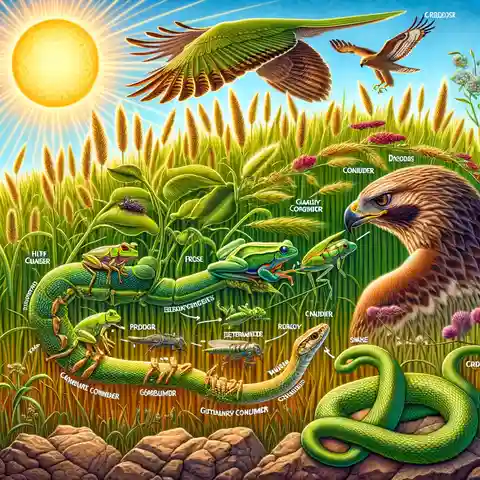
- Sun (Energy Source)
- Grass (Producer)
- Grasshopper (Primary Consumer)
- Frog (Secondary Consumer)
- Snake (Tertiary Consumer)
- Hawk (Quaternary Consumer)
2. Forest Ecosystem:
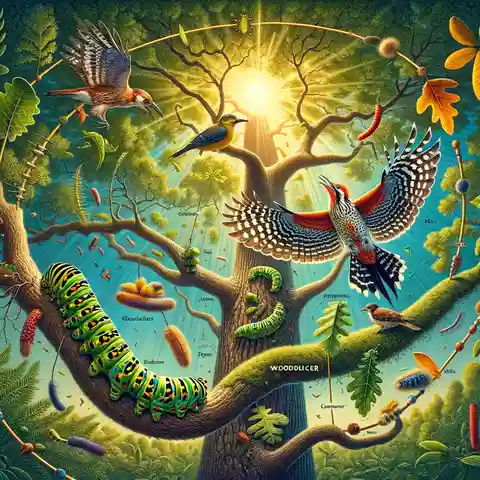
- Sun (Energy Source)
- Tree (Producer)
- Caterpillar (Primary Consumer)
- Bird (Secondary Consumer)
- Fox (Tertiary Consumer)
3. Aquatic Freshwater Ecosystem:
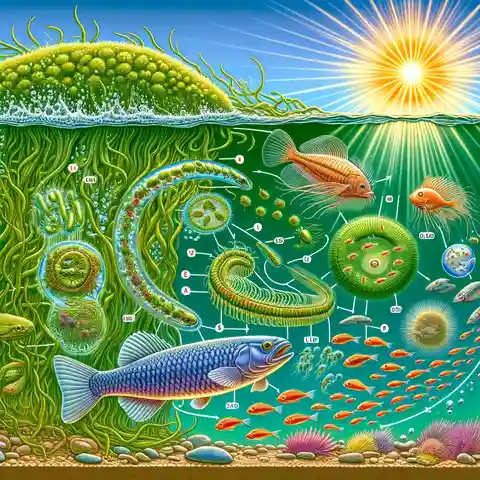
- Sun (Energy Source)
- Algae (Producer)
- Zooplankton (Primary Consumer)
- Small Fish (Secondary Consumer)
- Large Fish (Tertiary Consumer)
4. Ocean Ecosystem:
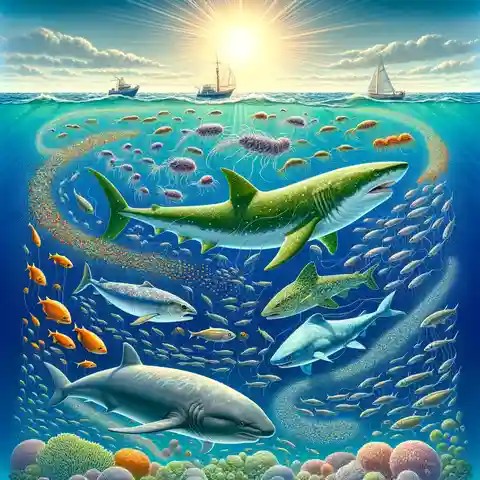
- Sun (Energy Source)
- Phytoplankton (Producer)
- Krill (Primary Consumer)
- Small Fish (Secondary Consumer)
- Seal (Tertiary Consumer)
- Shark (Quaternary Consumer)
5. Desert Ecosystem:
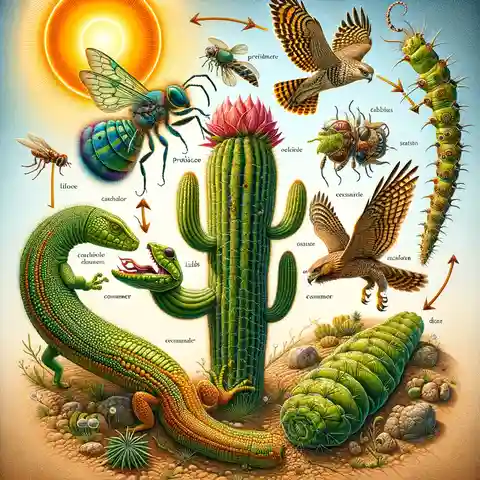
- Sun (Energy Source)
- Cactus (Producer)
- Insect (Primary Consumer)
- Lizard (Secondary Consumer)
- Snake (Tertiary Consumer)
- Hawk (Quaternary Consumer)
6. Deciduous Forest Ecosystem:

- Sun (Energy Source)
- Oak Tree (Producer)
- Caterpillar (Primary Consumer)
- Woodpecker (Secondary Consumer)
- Hawk (Tertiary Consumer)
7. Coral Reef Ecosystem:
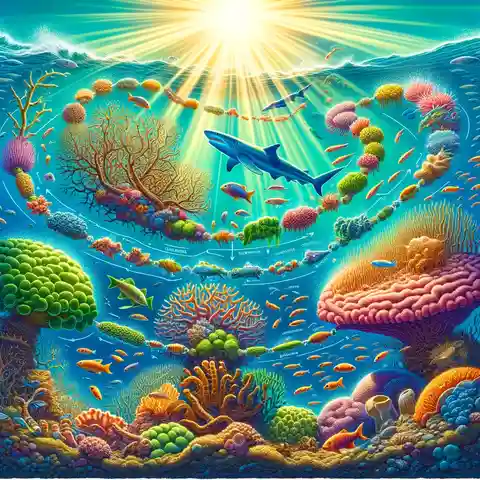
- Sun (Energy Source)
- Algae (Producer)
- Coral Polyps (Primary Consumer)
- Small Fish (Secondary Consumer)
- Shark (Tertiary Consumer)
8. Tropical Rainforest Ecosystem:
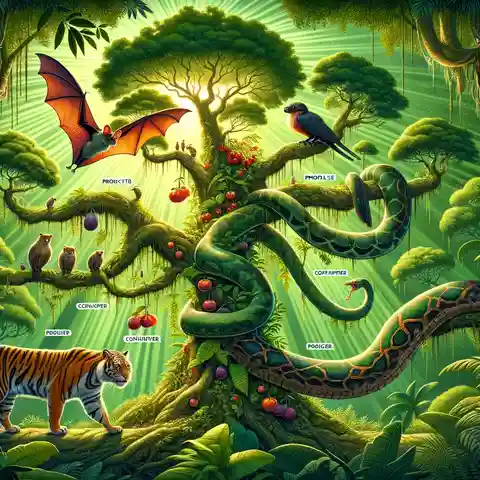
- Sun (Energy Source)
- Fig Tree (Producer)
- Fruit Bat (Primary Consumer)
- Python (Secondary Consumer)
- Tiger (Tertiary Consumer)
9. Urban Ecosystem:
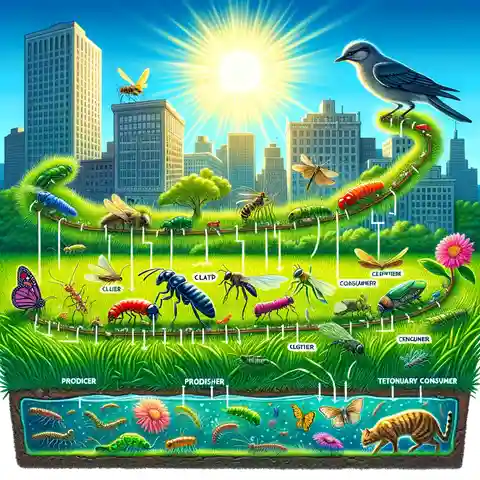
- Sun (Energy Source)
- Park Grass (Producer)
- Insect (Primary Consumer)
- Bird (Secondary Consumer)
- Cat (Tertiary Consumer)
10. Arctic Ecosystem:
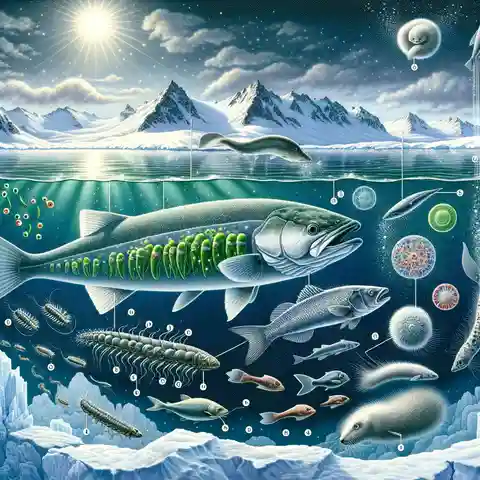
- Sun (Energy Source)
- Phytoplankton (Producer)
- Zooplankton (Primary Consumer)
- Arctic Cod (Secondary Consumer)
- Seal (Tertiary Consumer)
- Polar Bear (Quaternary Consumer)
This sequence demonstrates the interconnectedness of all life within an ecosystem
Why Food Chains are Important:
Food chains are like the secret recipes that make nature work so well. They’re important for many reasons, and understanding them can help us see how everything in nature is connected. Here is why food chains are important:
- Teamwork in Nature
Think of nature as a big team where everyone relies on someone else to survive. Food chains show us this awesome teamwork. Plants, animals, and even tiny organisms depend on each other. It’s like a game of tag, but instead of tagging, they share energy!
- Passing the Energy Baton
Like in a relay race, energy gets passed from one living thing to another in a food chain. It starts with the sun, then moves to plants, animals that eat those plants, and so on. This energy passing helps all creatures get the food they need to live.
- Keeping Everyone Just Right
Imagine if there were too many rabbits and not enough grass, or too many lions and not enough rabbits. Things would get pretty crazy, right? Food chains help keep the numbers of plants and animals right so everyone has enough to eat without running out.
- Balancing Act
Food chains are like nature’s way of balancing things out. They ensure that energy flows in a way that keeps the environment healthy. If one part of the chain gets out of whack, it can affect everything else.
- A Big Circle of Life
Food chains are about the circle of life. They show us how life goes on, with each part playing a role in keeping the planet alive and kicking. Every creature has its place in the food chain, from the smallest ant to the biggest elephant.
Why Should We Care?
Understanding and protecting food chains is important for keeping our world beautiful and full of life. So, next time you see a bird eating a worm or a flower reaching for the sun, remember the amazing food chain at work!
Human Role in Food Chains:
Imagine nature as a big web where everyone is connected, like friends in a giant playground.
Humans are like players who can choose different roles in this playground. Sometimes, we’re like the plant-eaters, munching on fruits and veggies.
Other times, we’re more like the meat-eaters, enjoying a hamburger. This ability to switch roles makes us unique in the web of life, and our choices can change how the playground works.
Environmental Impacts on Food Chains:
Sometimes, because of what people do or natural events, the playground of nature can change. Imagine if someone spilled paint on the slide; it wouldn’t be as fun to play on, right? In nature, pollution is like that paint spill, making it hard for plants and animals to thrive.
Some of the paint (or pollution) can stick to one animal and then get passed on to others that play with it, making even more animals unhappy.
Also, if fewer animals or plants are in the playground, it’s less fun to play, and everyone’s affected. That’s why caring for our big playground, nature, is so important.
Conclusion
Food chains help us understand how everything in nature is connected. They remind us to care for our planet so all living things can thrive together. So, learning about food chains and help keep them healthy. That way, we can make sure our planet stays happy and balanced!




